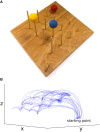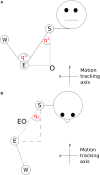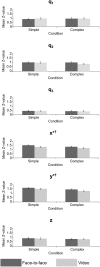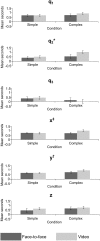Video stimuli reduce object-directed imitation accuracy: a novel two-person motion-tracking approach
- PMID: 26042073
- PMCID: PMC4436526
- DOI: 10.3389/fpsyg.2015.00644
Video stimuli reduce object-directed imitation accuracy: a novel two-person motion-tracking approach
Abstract
Imitation is an important form of social behavior, and research has aimed to discover and explain the neural and kinematic aspects of imitation. However, much of this research has featured single participants imitating in response to pre-recorded video stimuli. This is in spite of findings that show reduced neural activation to video vs. real life movement stimuli, particularly in the motor cortex. We investigated the degree to which video stimuli may affect the imitation process using a novel motion tracking paradigm with high spatial and temporal resolution. We recorded 14 positions on the hands, arms, and heads of two individuals in an imitation experiment. One individual freely moved within given parameters (moving balls across a series of pegs) and a second participant imitated. This task was performed with either simple (one ball) or complex (three balls) movement difficulty, and either face-to-face or via a live video projection. After an exploratory analysis, three dependent variables were chosen for examination: 3D grip position, joint angles in the arm, and grip aperture. A cross-correlation and multivariate analysis revealed that object-directed imitation task accuracy (as represented by grip position) was reduced in video compared to face-to-face feedback, and in complex compared to simple difficulty. This was most prevalent in the left-right and forward-back motions, relevant to the imitator sitting face-to-face with the actor or with a live projected video of the same actor. The results suggest that for tasks which require object-directed imitation, video stimuli may not be an ecologically valid way to present task materials. However, no similar effects were found in the joint angle and grip aperture variables, suggesting that there are limits to the influence of video stimuli on imitation. The implications of these results are discussed with regards to previous findings, and with suggestions for future experimentation.
Keywords: ecological methods; grip aperture; imitation; joint angles; kinematics; two-person.
Figures







References
Grants and funding
LinkOut - more resources
Full Text Sources
Other Literature Sources

